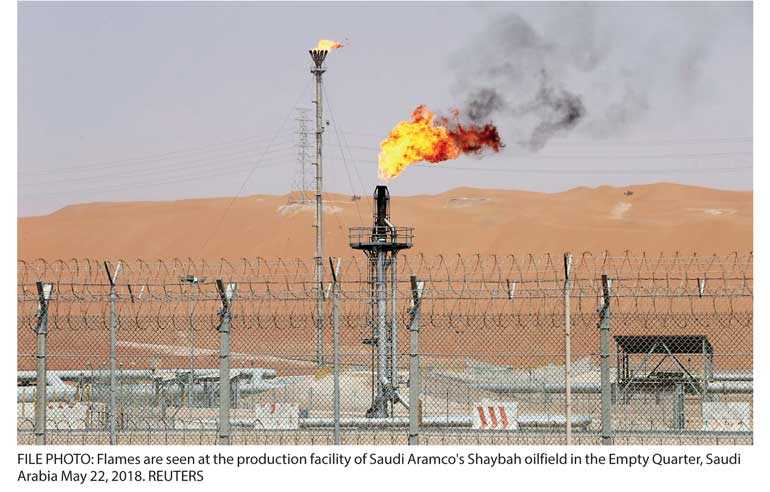Sunday Mar 09, 2025
Sunday Mar 09, 2025
Friday, 27 July 2018 00:00 - - {{hitsCtrl.values.hits}}
 TOKYO (Reuters): Brent crude led oil prices higher on Thursday, extending gains into a third day after Saudi Arabia suspended crude shipments through a strategic Red Sea shipping lane and as data showed US inventories fell to a 3-1/2 year low.
TOKYO (Reuters): Brent crude led oil prices higher on Thursday, extending gains into a third day after Saudi Arabia suspended crude shipments through a strategic Red Sea shipping lane and as data showed US inventories fell to a 3-1/2 year low.
Brent crude futures had risen 42 cents, or 0.6 percent, to $74.35 a barrel by 0648 GMT, after gaining 0.7 percent on Wednesday.
US West Texas Intermediate crude futures were up 5 cents at $69.35 a barrel, after climbing more than 1 percent in the previous session.
“The announcement this morning that the Saudis have closed some shipping lanes in the Gulf because of rebel Houthi attacks also gives the bulls something to launch off,” said Greg McKenna, chief market strategist at AxiTrader, also pointing to the drop in US inventories.
Saudi Arabia, the world’s biggest oil exporter, said on Thursday that it was “temporarily halting” all oil shipments through the strategic Red Sea shipping lane of Bab al-Mandeb after an attack on two big oil tankers by Yemen’s Iran-aligned Houthi movement.
Saudi Energy Minister Khalid al-Falih said in a statement that the Houthis had attacked two Saudi Very Large Crude Carriers in the Red Sea on Wednesday morning, one of which sustained minimal damage.
“Saudi Arabia is temporarily halting all oil shipments through Bab al-Mandeb Strait immediately until the situation becomes clearer and the maritime transit through Bab al-Mandeb is safe,” the minister said.
Most exports from the Gulf that transit the Suez Canal and the SUMED Pipeline also pass through Bab al-Mandeb strait.
An estimated 4.8 million barrels per day of crude oil and refined petroleum products flowed through this waterway in 2016 toward Europe, the United States and Asia, according to the US Energy Information Administration.
The Bab al-Mandeb strait, where the Red Sea meets the Gulf of Aden in the Arabian Sea, is only 20 km (12 miles) wide, making hundreds of ships potentially easy targets.
Prices were also supported by official data showing US crude oil inventories last week tumbled more than expected to their lowest level since 2015 as exports jumped and stocks at the Cushing hub dropped. Crude inventories fell 6.1 million barrels in the week to July 20, compared with analyst expectations for a decrease of 2.3 million barrels, the EIA said on Wednesday.
At 404.9 million barrels, inventories, not including the nation’s emergency petroleum reserve, were at their lowest level since February 2015.
The threat of a transatlantic trade war eased after US President Donald Trump agreed on Wednesday to refrain from imposing car tariffs on the European Union while the parties discuss cutting other trade barriers.
Discover Kapruka, the leading online shopping platform in Sri Lanka, where you can conveniently send Gifts and Flowers to your loved ones for any event including Valentine ’s Day. Explore a wide range of popular Shopping Categories on Kapruka, including Toys, Groceries, Electronics, Birthday Cakes, Fruits, Chocolates, Flower Bouquets, Clothing, Watches, Lingerie, Gift Sets and Jewellery. Also if you’re interested in selling with Kapruka, Partner Central by Kapruka is the best solution to start with. Moreover, through Kapruka Global Shop, you can also enjoy the convenience of purchasing products from renowned platforms like Amazon and eBay and have them delivered to Sri Lanka.
Discover Kapruka, the leading online shopping platform in Sri Lanka, where you can conveniently send Gifts and Flowers to your loved ones for any event including Valentine ’s Day. Explore a wide range of popular Shopping Categories on Kapruka, including Toys, Groceries, Electronics, Birthday Cakes, Fruits, Chocolates, Flower Bouquets, Clothing, Watches, Lingerie, Gift Sets and Jewellery. Also if you’re interested in selling with Kapruka, Partner Central by Kapruka is the best solution to start with. Moreover, through Kapruka Global Shop, you can also enjoy the convenience of purchasing products from renowned platforms like Amazon and eBay and have them delivered to Sri Lanka.